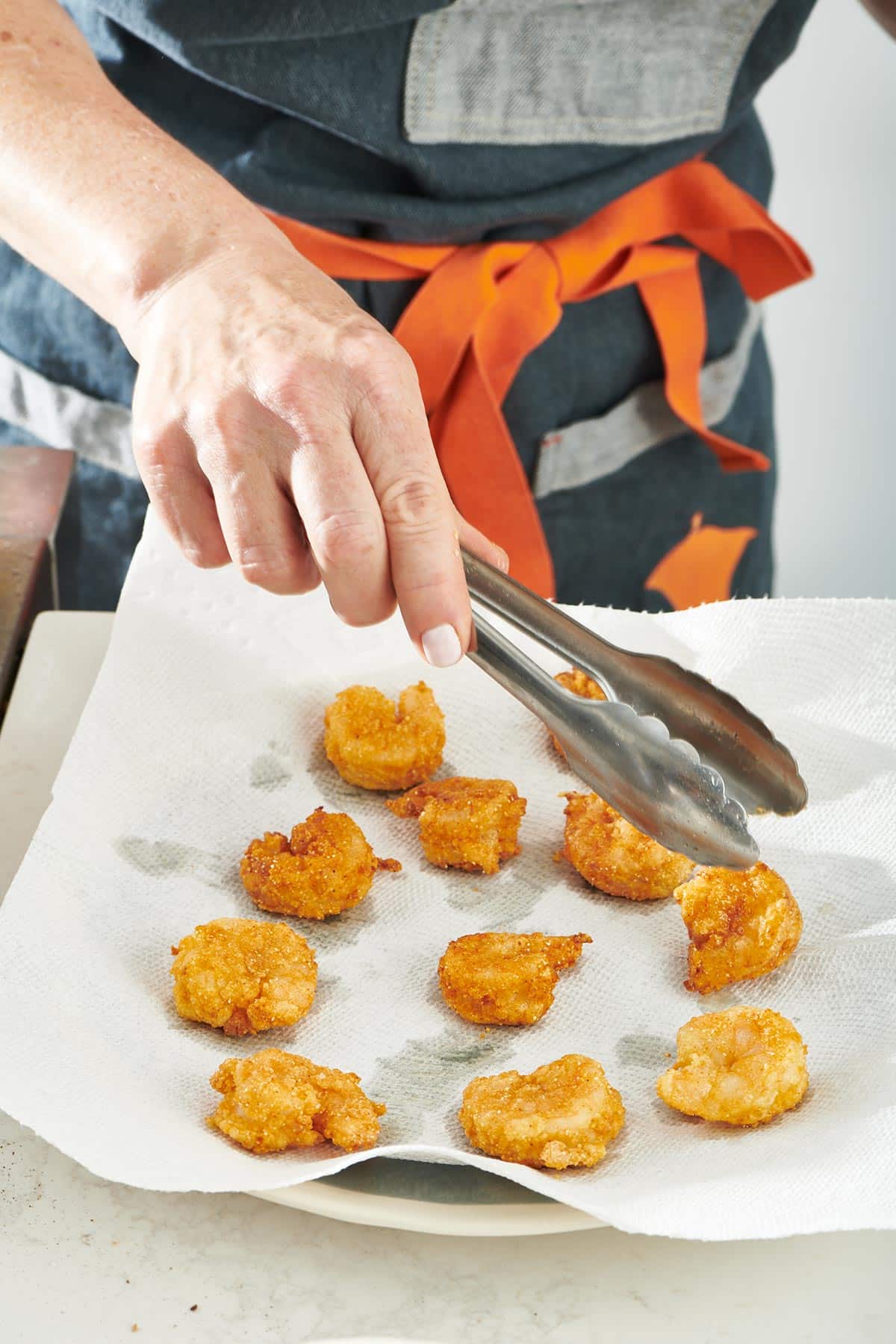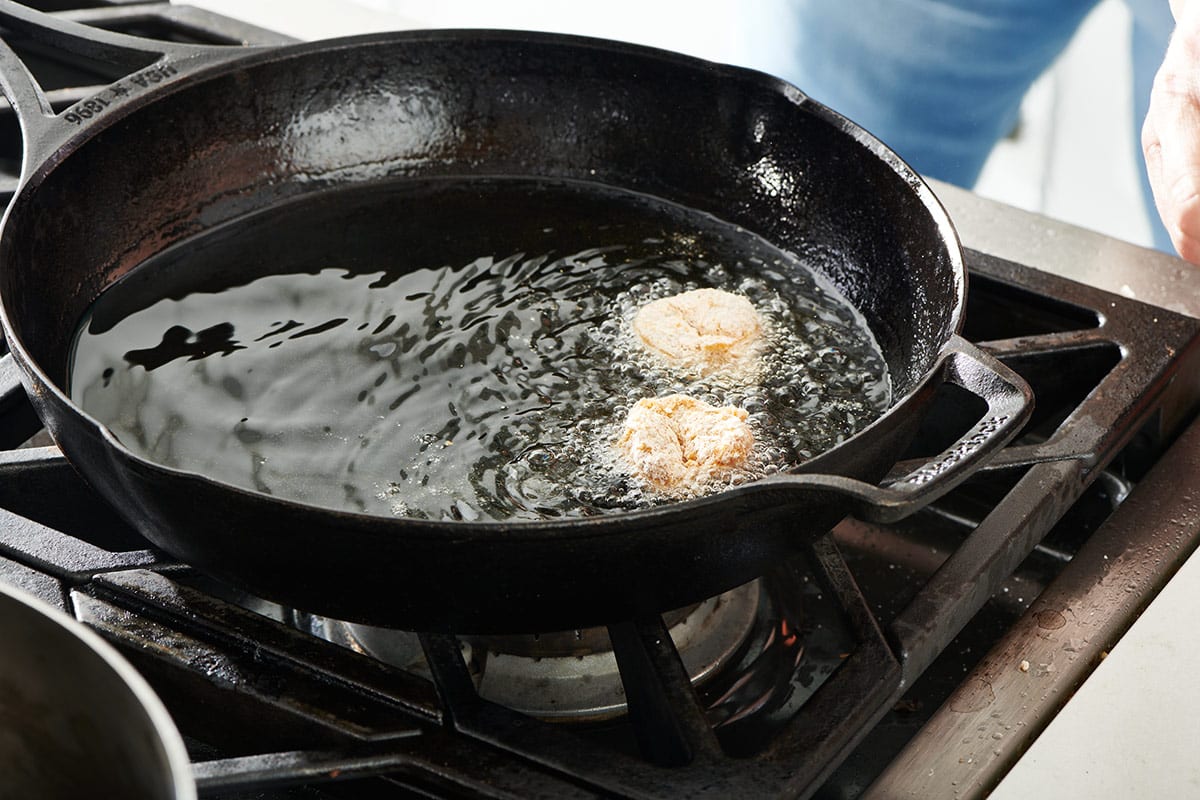Frying shrimp at home is so much easier than one would think. With only an inch of oil in the pan, you can make hot, crispy shrimp that you can dip in any sauce, like Tartar, Dill, or Remoulade. You could also put them on a shrimp po’boy and make it a real treat. Shrimp take only 3 minutes to fry, so they are FAST.
As a seafood lover, frying shrimp in a light crispy flour coating is one of my favorite cooking methods. The flour seals in moisture while providing a delicate crunch when done right. But can you actually fry shrimp in flour? How do you get the optimal flavor and texture? Here I’ll cover everything you need to know about flour-fried shrimp.
An Overview of Frying Shrimp in Flour
The short answer is yes, shrimp can absolutely be fried in flour for delicious results! Flour is a versatile dredging ingredient that, when paired with shrimp, yields a lovely golden crust and tender interior. The flour adheres nicely to seal in juices without overwhelming the inherent shrimp flavor.
While shrimp can be fried naked, the flour coating protects it from drying out and provides that satisfying crunch we love in fried foods. The coating also allows you to layer on spices, herbs, salt and pepper for added flavor. When fried at the right temperature, flour-coated shrimp becomes beautifully crispy.
So by all means grab a bag of flour and some fresh shrimp and fry away! Just keep a few tips in mind for the best outcomes. Properly prepping and frying the shrimp while using the right flour and oil is key.
Best Practices for Frying Shrimp in Flour
Frying shrimp in flour is simple, but there are some best practices to follow:
-
Choose raw, peeled shrimp – The coating won’t adhere well to cooked shrimp. Leave the tails on for presentation.
-
Pat shrimp dry – Excess moisture prevents the flour from sticking. Blot with paper towels.
-
Use all-purpose or cornstarch flour – These create a light, crispy coating. Avoid self-rising flour.
-
Season the flour – Salt, pepper, spices, garlic powder, etc. boost the flavor.
-
Chill coated shrimp – Letting shrimp rest in the fridge helps the coating set before frying.
-
Use refined oil with high smoke point – Canola, vegetable, peanut or grapeseed oils work well.
-
Fry at 350-375°F – This prevents burning and cooks the shrimp perfectly.
-
Fry in batches – Avoid overcrowding the pan which lowers oil temperature.
-
Flip halfway – Ensures even browning and cooking through the center.
-
Drain on paper towels – Removes excess grease for better presentation and taste.
Follow these tips and you’ll be enjoying restaurant-quality fried shrimp at home in no time!
Must-Have Equipment for Frying Shrimp
Having the right gear makes frying shrimp much easier:
-
Instant-read thermometer – Essential for monitoring oil temperature.
-
Deep fryer – Helps maintain consistent oil temps (not required though).
-
Heavy skillet or pot – Choose a heavy-bottomed pan to evenly distribute heat.
-
Slotted spoon or tongs – Removes shrimp neatly from hot oil. Metal mesh spider skimmers work too.
-
Paper towels – Draining fried shrimp prevents greasiness.
-
Cooling racks – Lets shrimp “breathe” after frying versus sitting in oil. Improves texture.
Investing in some basic frying tools really elevates your shrimp game. But don’t worry, you can get by with just a good skillet and instant thermometer if needed.
Choosing the Best Shrimp for Frying
Not all shrimp are created equal when it comes to frying. Here are some buying tips:
-
Raw, shell on shrimp – You’ll need to peel/devein yourself. Adds freshness.
-
Raw, peeled & deveined shrimp – Convenient if short on prep time. Still high quality.
-
16-20 or 21-25 size shrimp – Good middle ground. Not too small or large.
-
IQF shrimp – Individually Quick Frozen shrimp are convenient and consistent.
-
Fresh, never frozen – Premium option if available. Excellent texture.
-
Wild caught or sustainably farmed – Eco-friendly choices like Gulf shrimp.
-
Firm, shiny shrimp – Signifies freshness with a pleasing texture. Avoid mushy.
-
Unseasoned – If pre-seasoned, flavors may clash with flour coating.
Select shrimp size, freshness and origin based on your preferences and what’s available. The key is starting with quality shrimp for the best end results.
Coating Shrimp in Flour
Now we get to the fun part – prepping and coating the shrimp! Here are two easy methods:
Bread shrimp:
-
Set up flour, egg wash, and breadcrumb stations
-
Pat shrimp dry, then coat in flour, shaking off excess
-
Dip in egg wash then press into breadcrumbs
-
Let coated shrimp rest 15 minutes in the fridge before frying
Double-dredge shrimp:
-
Mix flour, spices and seasonings in a bowl
-
Beat eggs with milk or buttermilk in another bowl
-
Pat shrimp dry then coat in flour mixture
-
Dip into egg wash then back into the flour mixture
-
Set breaded shrimp on a baking sheet and refrigerate 15 minutes before frying
The double-dredge method ensures the coating really sticks to the shrimp. Refrigerating allows the crust to adhere better as well.
How to Fry Shrimp Properly in a Skillet
Once your shrimp are floured up, it’s go time! Here is a simple frying method:
-
Heat 1 inch oil in a heavy skillet over medium-high heat to 350°F
-
Fry shrimp in batches without overcrowding, about 2-3 minutes per side
-
Flip shrimp halfway through frying until golden brown
-
Remove shrimp with a slotted spoon and drain on a paper towel-lined plate
-
Bring oil back up to temperature between batches
-
Toss fried shrimp in extra seasoning or dipping sauce if desired
Be sure to monitor oil temperature closely as you fry. Adjust heat as needed to maintain that 350° sweet spot.
Serving Up Your Crispy Fried Shrimp
Now it’s time to enjoy your flavorful fried shrimp! Here are some fun ways to serve them up:
-
Pile high on po’ boy sandwiches with lettuce, tomatoes and remoulade
-
Toss into fresh salad greens for a delicious protein punch
-
Serve as an appetizer with creative dipping sauces for dunking
-
Add to tacos, rice bowls or pasta for a savory twist
-
Sprinkle with extra spices like Old Bay seasoning or cajun rub
However you choose to serve them, fried shrimp coated in flour make for finger-licking good eating! Now that you’re armed with all the info and tips, I hope you’ll give flour-fried shrimp a try soon. Enjoy!

Tips for Frying Shrimp
- Use raw, peeled, deveined shrimp for this recipe.
- With one hand hold the wet ingredients and the other the dry ones as you coat the shrimp in the milk-egg mixture and then the flour mixture. This will keep everything from getting lumpy, sticky, and messy.
- Make sure the oil is just hot enough, not too hot (see below).
- Fry the shrimp one at a time so they don’t stick together in the pan.
- Before putting the baking sheet in the fridge for 15 minutes, coat all of the shrimp with bread crumbs. This will help the coating stick to the shrimp when you fry them.
- Don’t overcook the shrimp. They are done when they turn golden brown.
- Drain the shrimp on paper towels to get rid of any extra oil.

Oil Temperature for Frying Shrimp
- Oil Temperature: For the best shrimp fries, the oil should be between 360 and 365 degrees so that the outside turns golden and the inside is cooked but still soft. If you don’t have an instant-read or candy thermometer, add one shrimp after the oil starts to shimmer. After about two minutes, if it starts to sizzle and turn golden brown, the oil is at the right temperature. But I believe every cook should have a good instant-read thermometer. If you need a reason to buy one, this could be it!

- Wait for the oil to warm up again. You might need to wait for the oil to warm up again between shrimp batches. When you add too many shrimp at once, the oil temperature will drop, and the shrimp won’t get nice and brown and crunchy. Because they cook quickly, fry them up in several groups!
How To Make The BEST Fried Shrimp| Better Than Popeyes| Crispy Fried Shrimp
FAQ
How do you keep batter from falling off shrimp?
Why do you soak shrimp in milk before frying?
Can you fry shrimp with flour?
Yes, frying shrimp with flour in a pan is another common method. Heat oil in a deep-sided skillet or frying pan over medium heat. Gently place the coated shrimp into the hot oil, ensuring not to overcrowd the pan. Cook each side for a few minutes until they become golden brown and crispy.
Can I eat raw shrimp?
Eating raw shrimp is not recommended. Raw shrimp can contain bacteria that can cause food poisoning. It is also a good source of purines, which can trigger gout attacks. If you want to eat shrimp, cook it thoroughly to reduce the risk of food poisoning and to help prevent gout attacks. Cook shrimp until it is opaque and pink to ensure that it is safe to eat.
Can you make fried shrimp at home?
Southern Fried Shrimp is crunchy and delicious and so easy to make! Try this recipe restaurant favorite that you can make at home in just minutes! This crispy shrimp batter is made with a buttermilk and Old Bay seasoned flour for a flavorful and delicious coating. A favorite dinner or easy appetizer for any gathering.
Can you fry shrimp in a deep fryer?
A deep-fry thermometer is super handy to make sure your oil stays at the proper temperature. You can also use a deep fryer for this shrimp recipe. Shrimp cook really quickly. The oil temperature should be 350-375° and the shrimp will cook in 1-2 minutes. What Kind of Oil is Best for Fried Shrimp? Peanut Oil is the best.
